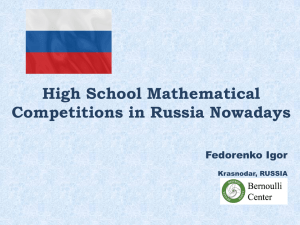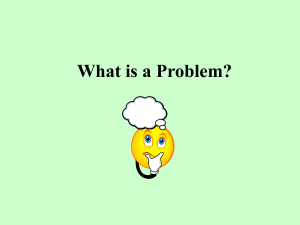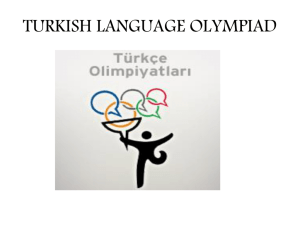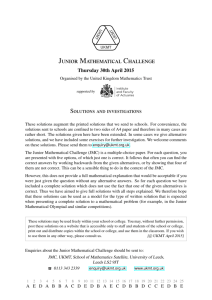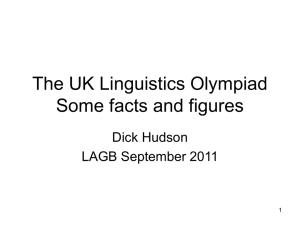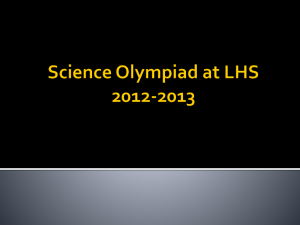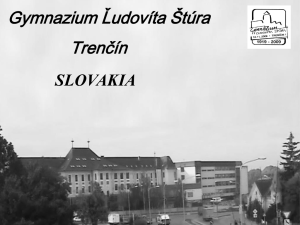Document
advertisement
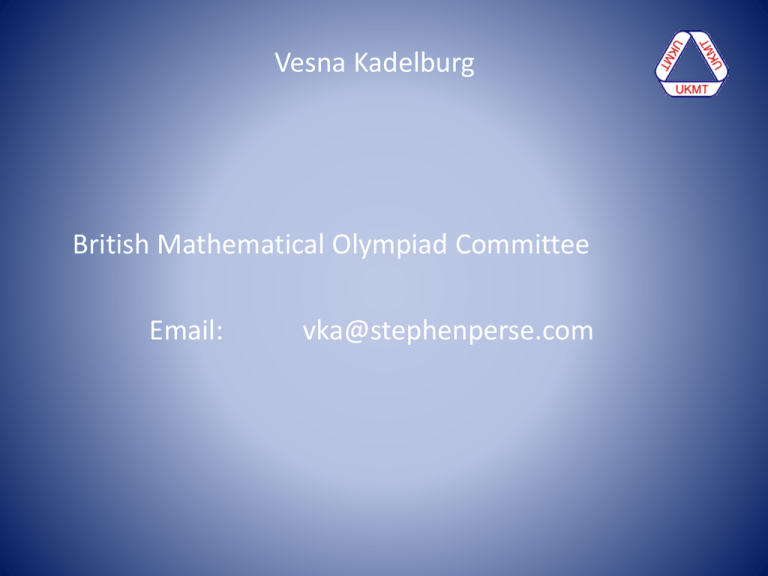
Vesna Kadelburg British Mathematical Olympiad Committee Email: vka@stephenperse.com UKMT Activities Maths Challenges: Junior, Intermediate and Senior Follow on rounds: Junior Mathematical Olympiad - JMO; Intermediate Mathematical Olympiad and Kangaroo (suite of 3 Olympiad and 2 multiple choice European Kangaroo papers) – IMOK; British Mathematical Olympiad Round 1 – BMO1 and the new Senior Kangaroo (the first Senior Kangaroo took place last academic year held on the same day as BMO1 - not multiple choice but single answers marked by a machine). Over 600,000 pupils from more than 4000 schools take the Challenges each year. UKMT Activities Team Challenges: Team Challenge (years 8 and 9) and Senior Team Challenge (years 12 and 13), a series of regional events run throughout the UK (Feb, March and April for TMC, Oct and Nov for STMC) with a National Final held in London for both events. Teams of four students, a range of tasks for the day, very popular and great fun. Primary Team Maths Resources New on UKMT website, can be used in the classroom, or as a competition within a school or for a group of schools (e.g. secondaries with feeder schools), also useful in secondary school (probably lower ability for revision) Mathematical Olympiad for Girls (UKMOG) Inaugural event hosted by Murray Edwards College in 2012, same format as the International Olympiad (two papers over two days). Aim to encourage and inspire girls, meet other female mathematicians. UKMT Activities Mentoring schemes for able pupils, ran externally or in schools Summer Schools: week-long residential schools each year for able pupils in the UK . Five schools this year. Training and selection of the team to represent the UK at the International Mathematical Olympiad (BMO1 leads to BMO round 2, and training events in Oxford, Hungary, Trinity College Cambridge, and Oundle School). Also UK teams at the Balkans Mathematical Olympiad, Romanian Masters in Mathematics and the European Girls’ Mathematical Olympiad. UKMT Activities Publications - past papers, and UKMT publications. UKMT are European agents for the ‘Art of Problem Solving’ books. New books: - A problem solver’s handbook by Andrew Jobbings - The Geometry of the triangle by Gerry Leversha All books on sale here today. Testbase. A CD ROM containing 825 questions from the Junior, Intermediate and Senior challenges from 1997 to 2008 and can perform searches on Challenge, topic, difficulty of the questions and allows people to create their own question sheets from them. UKMT Yearbook – sent to all schools which participate in the Challenges. UKMT Activities Teacher Meetings Mathematical Circles: Two-day long non residential events packed with mathematics beyond the curriculum, aimed at Year 10 pupils. These are new events and we’ll be organising more of them in the next couple of years, UKMT will contact your school when there is one in your area. UKMT website: www.ukmt.org.uk . Extended challenge solutions, including some extension material. Resources website: www.ukmt-resources.org.uk All Challenge papers since 2004; many other resources. The Millfield Team Competition (with thanks to Ceri Fides) I collect about 15 questions on a particular topic using the testbase software (or you could even just use a whole IMC or SMC paper) and then print out sets of questions on coloured paper. Each team gets one set of questions. Each question has three boxes at the bottom for answers (for this reason I normally remove the multiple choice option and just look for numerical answers. The questions are each worth different amounts of points and the team to answer a question first gets double points. The points for each question and current leader board are displayed throughout the lesson. The teacher just sits at the desk and students bring questions up. If they are correct hold onto the slips and if they are incorrect cross out one of the boxes and hand the slip back. When the teacher gets a chance they can record the scores on the score board (this is where the colours are invaluable as you can see which team handed in what and I keep all the slips in a pile so I can see which came in first). Qu 1 2 3 4 5 6 7 8 9 10 11 12 13 14 Pts 3 3 3 3 4 4 5 7 5 5 5 6 8 9 Total A 6 3 3 6 8 8 10 14 12 16 18 104 B 3 3 3 3 4 9 25 C 3 3 6 D 3 6 TEAM The first team to complete a question will get double points 6 10 18 9 28 Relay competition • Print out each question on a separate piece of paper, and make as many copies as there are teams (teams of 3-4 work well, or 4-6 if split into two groups) • One member of each team comes to the front desk to collect Q1 • On completing Q1 they bring the answer to the front. If it’s correct sore 2 points and get Q2.If incorrect they can have another go for 1 point. After that give them Q2. • Ask them to put the team number on each sheet and keep the sheets, put 2 or 1 for scores, then add up points at the end. • Alternative: Each team splits into two groups who answer alternate questions and then take the next question to the other team. Mini Relay • Each team consists of either two or four pairs (or threes). • With four pairs, each pair gets one question. With two pairs, one gets 1&3, the other 2&4. • Questions 2, 3 and 4 use the answer from the previous question, but some working can be done before the answer is received. • The pairs pass the answer sheet until all four questions have answers. The last pair then bring the sheet to the front desk. • If all four answers are correct award 12 points. Otherwise award 3 points for each correct answer until the first wrong one. Mark the wrong answer and return the sheet, so they can have another go (starting with the pair who gave the first incorrect answer). • The team to get four correct answers first gets additional 3 points. (See Primary or Senior Team Challenge materials on the website) Question 4 T stands for the number you will receive. I travel T km to work and it takes me 40 minutes. What is my average speed in kilometres per hour? Write down your answer. Question 3 T stands for the number you will receive. Work out: 1/5 of T plus 1/6 of (T + 1) Pass on your answer. Question 2 T stands for the number you will receive. A triangle has one angle of 2T – 20 degrees and one angle of 3T + 10 degrees. How many degrees are there in the third angle? Pass on your answer. Question 1 The sum of two whole numbers is 30 and their difference is 20. Pass on the larger of these two numbers. Crossnumbers From Primary Resources UKMT website: www.ukmt.org.uk Head to Head Head to Head 2 7 12 9 5 42 150 999 5 15 25 19 11 85 301 1999 f(n) = 2n + 1 Head to Head 2 5 10 4 7 28 103 19 7 30 0.5 200 52 903 3.25 40 003 f(n) = n2 + 3 Head to Head 4 6 14 34 15 11 98 128 2 3 7 17 5 11 7 2 f(n) = largest prime factor of n Head to Head 8 12 16 24 40 6 99 5000 2 3 4 4 6 2 9 70 f(n) = integer part of square root of n Head to Head 6 12 16 1 3 8 11 20 3 6 8 3 5 5 6 6 Six Twelve Sixteen One Three Eight Eleven Twenty f(n) = number of letters in the word n ‘Same total’ problems IMC 2012 Q8 Seb has been challenged to place the numbers 1 to 9 inclusive in the nine regions formed by the Olympic rings s that there is exactly one number in each region and the sum of the numbers in each ring is 11. The diagram shows part of his solution. What number should replace * ? A 6 . B 4 C 3 D 2 E 1 9 * 5 8 We can immediately place 2, 4 and 3 in the spaces shown. So the values of c, d, e are 1, 6, 7 in some order. If c = 1 then d = 6, but then e would need to equal 2, not 7. If c = 6, then d =1, e = 7 and this is a valid solution. Finally, if c = 7 then d would need to equal 0, which is not possible. So in the only possible solution, * is replaced by 6. c + d = 7, d + e = 8 So c is one less then e, and the only possibility is c = 6, e = 7. 9 4 2 5 c d e 3 8 2001 JMO QB1 The numbers from 1 to 7 inclusive are to be placed, one per square, in the figure on the right so that the totals of the three numbers in each of the three straight lines is the same. In how many different ways can this be done if the numbers 1 and 2 must be in the positions shown? 1 2 1 x y 2 z When the three equal totals are added up, the numbers 2 and x appear twice and all other number appear once. Now the sum of the numbers from 1 to 7 inclusive is 28 and therefore the sum of the three equal totals will be 28 + x + 2 = 30 +x. This must be a multiple of 3 and hence x must also be a multiple of 3,i.e. x = 3 or 6. If x =3, the total of each line = 33/ 3 = 11 and therefore y = 6 and z = 7. The two remaining squares are filled with 4 and 5 so this may be done in two different ways. If x = 6, the total of each line = 36 /3 = 12 and therefore y = 4 and z = 5. The two remaining squares are filled with 3 and 7 so this may also be done in two different ways. There are, therefore, four different ways of completing the grid: 1 5 1 4 3 6 2 4 1 7 3 7 1 3 7 6 2 5 6 5 4 2 7 3 7 6 2 3 2006 JMO QB6 The numbers 1 to 7 are to be placed in the seven regions formed by three overlapping circles, with 6 in the central region, so that no region is empty and the total of the numbers in each circle is T. What values of T are possible? a d Let the numbers inside the regions be a, b, c, d, e, f as shown. Then: a + d + e + 6 = T; b + d + f + 6 = T; c + e + f + 6 = T. Adding these equations gives a + b + c + 2d + 2e + 2f + 18 = 3T. b e f c Now a, b, c, d, e, f are 1, 2, 3, 4, 5, 7 in some order, so a + b + c + d + e + f = 22. Therefore 22 + d + e + f + 18 = 3T, that is 40 + d + e + f = 3T. The minimum value of d + e + f = 1 + 2 + 3 = 6 and its maximum value = 4 + 5 + 7 = 16. So 46 ≤ 3T ≤ 56 Since T is a positive integer, it cannot, then, take any values other than 16, 17 or 18. If T = 16, then d + e + f = 8 and the task may be completed with a = 7, b = 4, c = 3, d = 1, e = 2, f = 5. If T = 17, then d + e + f = 11 . However, a + d + e + 6 = T = 17, so a + d + e = 11. This requires a to equal f, which is impossible, so T cannot be 17. If T = 18, then d + e + f = 14 and the task may be completed with a = 5, b = 2, c = 1, d = 3, e = 4, f = 7. The only possible values of T, then, are 16 and 18. 2004 JMO QB6 The diagram must be completed so that each square contains a different whole number from 1 to 12 inclusive and also so that the four numbers in the set of squares along each edge have the same total. In how many different ways can the diagram be completed correctly? 3 6 5 12 2004 JMO QB6 The total of the numbers in the four rows = 78 + 5 + 6 + 12 + x = 101 + x x 3 So 101 + x is a multiple of 4. Possible values of x are 3, 7, 11 but 3 is allocated. If x = 7 then each row totals 27. If x = 11 then each row totals 28. 6 5 12 2004 JMO QB6 If x = 7 then each row totals 27, so y = 12. (Impossible as 12 already allocated.) 7 3 y 6 5 12 2004 JMO QB6 If x = 11 then each row totals 28, so y = 9. 11 3 y 6 5 12 2004 JMO QB6 Total 11 11 3 Numbers remaining: 1, 2, 4, 7, 8, 10 9 6 5 2 8 Total 11 12 Total 10 2004 JMO QB6 Total 11 11 3 Numbers remaining: 1, 4, 7, 10 9 6 5 Number of different ways = 16 8 Total 11 2 12 Total 10 Proving it’s impossible Two opposite corner squares are removed from a chessboard. Can the resulting board be covered by 2x1 dominoes? TETROMINOES • How many different tetrominoes are there? Can the seven tetrominoes be used to fill the 7 x 4 rectangle? B A Find a route from room A to room B which goes through every other room exactly once. UKMT website: www.ukmt.org.uk . Extended challenge solutions, including some extension material. Resources website: www.ukmt-resources.org.uk All Challenge papers since 2004; many other resources.


